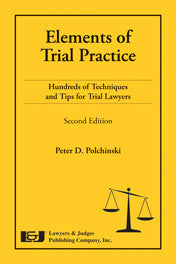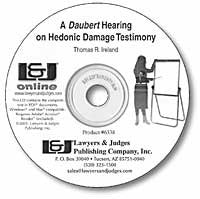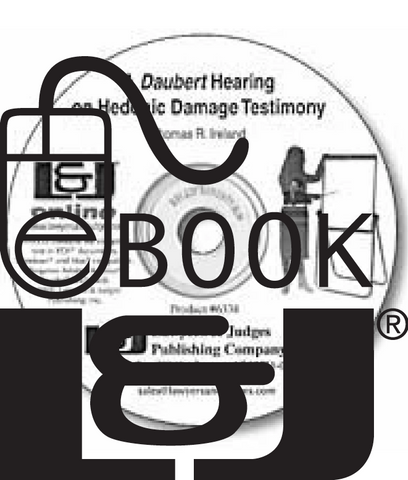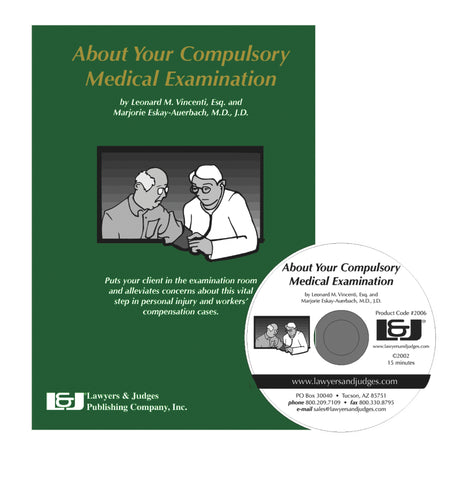
Elements of Trial Practice: Hundreds of Techniques and Tips for Trial Lawyers, Second Edition
- Author: Peter D. Polchinski
- ISBN 10: 1-933264-69-1
- ISBN 13: 978-1-933264-69-1
- Copyright Date Ed January 6, 2012
- Pages: 144
- Binding Information: Softbound
- Size: 6 ✕ 9 Inches (US)
An invaluable guide for the trial attorney.
To win at trial, you must present your case clearly, simply, persuasively, and fairly, while you undermine your adversary’s case in the same manner. Achieving excellence in trial advocacy is a lifelong pursuit. Nevertheless, trial skills and a basic understanding of this art can be learned, beginning with this book. Short and persuasive, this book wastes no words. You’ll discover how to select a favorable jury, prepare your witnesses, deliver powerful opening statements, conduct an effective direct examination, cross-examine any witness, introduce exhibits, impeach their witnesses, control consulting experts, and win the case on summation.
Elements of Trial Practice, Second Edition will become your essential, instant-access reference for trial. This new edition includes expansions, revisions and updates. Armed with its many valuable techniques, you will approach trial practice with new enthusiasm and confidence.
This book is also available as an eBook. Click here to purchase and download:
Topics covered include:
- Direct examination
- Introduction of exhibits
- Witness preparation
- Cross examination
- Expert witnesses
- Opening statement
- Summation
Table of Contents
I. Direct Examination
1. Ask non-leading questions.
2. Ask closed-ended questions.
3. Use simple words.
4. Omit unnecessary headers.
5. Use transitions and looping.
6. Provide visual images.
7. Introduce conversations or their results.
8. Write your questions.
9. Take command of the witness and the courtroom.
10. Conduct re-direct when necessary.
11. Read deposition testimony effectively at trial.
II. Introduction of Exhibits
1. Have your exhibit marked for identification.
2. Ask the proper foundation questions and have your exhibit admitted
in evidence.
3. Use the exhibit.
4. Refresh recollection and admit recorded recollection.
III. Witness Preparation
1. Tell the truth and keep your composure.
2. Conduct short, multiple prep sessions.
3. Cover the facts.
4. Prepare the witness for direct and cross-examination.
IV. Cross-Examination
1. Be fearless.
2. Prepare before trial.
3. Evaluate your witness.
4. Write your questions.
5. Listen to the direct.
6. Obtain admissions and corroborate before you attack.
7. Do not ask questions—state facts.
8. Use repetitive strings.
9. Impeach with prior inconsistent statements.
10. Cross-examine the witness with poise and confidence.
V. Expert Witnesses
1. Determine whether you need an expert.
2. Learn the subject.
3. Prepare for cross-examination.
4. Cross-examine the expert with poise and confidence.
5. Conduct a clear and persuasive direct.
VI. Opening Statement
1. Argue your case in the opening statement.
2. Organize and write your opening.
3. Talk to the jury.
4. Always argue affirmatively.
5. Avoid common errors.
VII. Summation
1. Prepare your summation before and during trial.
2. Write and edit your summation.
3. Argue your case forcefully, clearly and persuasively.
4. Prepare your requests to charge.
5. Argue the required motions for judgment.
VIII. Jury Selection
1. Select jurors who will listen to you.
2. Learn the court’s rules for jury selection.
3. Consider basic juror profiles.
4. Write your most important questions.
5. Present yourself and your case to the jury panel.
IX. Ethics and Courtroom Protocol
1. Hold yourself to the highest ethical standards.
2. Establish a good relationship with the judge.
3. Learn the rules of evidence.




